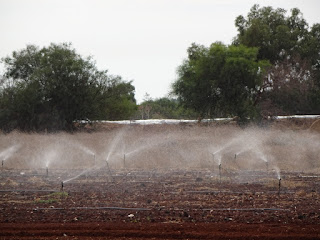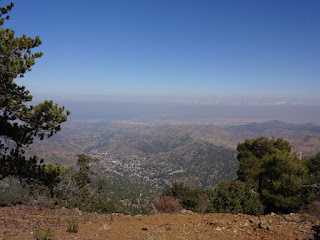Late September and early October was probably not the best time to hike across Cyprus. Vegetation had been dried by the summer sun, dusty yellow and brittle. It must have been green in the spring and full of flowers (see those recorded by a previous blogger). Although later in the year it was still very hot for walking, around 30 degrees in the afternoon, although I was told it was a late heatwave.
While the brochure for the route is no longer available from the Cyprus Tourist Organisation, there are plenty of E4 signs scattered across the country, yellow diamonds with a black E4 in the centre as in Greece. Not enough though, to navigate by, for that you really need to download a track onto your GPS or smartphone (see links on the daily blog pages for the GPS track of my route). I used a Navitracks map of Cyprus on my GPS, but the Europe OSM (Open Street Map) map I had, or indeed Google Maps, was almost as good. I was slightly confused as some signs with the E4 logo point to nearby towns with facilities, but the E4 does not necessarily go to those towns. The frequency of the waymarks various greatly and sometimes only the yellow and white painted poles remain, with ancient snail shells stuck to them.
Much of the route is on vehicle tracks, forest and farm roads, surfaced with gravel or white and dusty from the underlying limestone. Tarmac roads, when they are followed, were invariably quiet. There were however some good sections of footpath (monopati), often nature trails with signs naming the vegetation or rocks (although note that at the season you walk in, the named plants may not be visible). Thinking I would be mainly on forest or farm tracks I wore hiking shoes for the first time on a longer trip like this. Probably a mistake as stones, burs and sharp bits of grass easily got into my shoes and/or attached themselves to my socks in a way that required painstaking efforts to remove. A tear which developed in the fabric suggested they would not cover many more kilometres, although they were not some cheap trainers. Next time I will wear boots.
The E4 in Cyprus can be split into three. Firstly, the section from Pafos to Lysos across low hills, among scrub and vineyards, and around the Akamas peninsula. Tourists racing past in motorised buggies, raising the dust, can be a bit disconcerting in places. Best for its villages, which the E4 tends to bypass, they are worth a visit for their coffee shops, accommodation and general atmosphere. Although not on the route, I recommend a visit to the mosaics at Pafos.
The second section is across the Troodos and surrounding mountains. Classic walking country among pines, monasteries and ancient villages, the section from Lysos to Stavrovouni monastery is the best part of the E4 in Cyprus. The route meanders around the mountains so it takes a long time to reach a place that may be only a short distance away. There are certainly quicker ways to cross the mountains but that misses the main objective of visiting places you would not otherwise see, enjoying the scenery and changing patterns of light at a slow pace. Most of the time you will be on your own but at a few popular spots, such as the Kykkos monastery and Kaledonia waterfall, there are plenty of people about.
In the third section, the E4 extends to Cape Greco and then doubles back on itself and returns to the Larnaca area. Others have ended their trip on reaching Cape Greco, and little need be lost by doing this. The area has its interests, the residues of history in the form of the UN buffer zone and the British base, and the resort town of Ayia Napa was more enjoyable than I expected.
The B&B accommodation I stayed in was an unexpected pleasure, a chance to enjoy a traditional house and listen to the owners. Hotels were more predictable. The way some were aimed at the British tourist, was enjoyable in a kitsch sort of way. In the mountain section it is difficult to avoid a few nights of camping, but it has the advantage of seeing the sun rise and set across the pines. Forest campsites and picnic sites, with water and many with toilets, make camping a bit easier.
Long distance walking is not a popular Cypriot activity and I did not meet any other backpackers, but it is an interesting country with a lot of history, old villages and a variety of landscapes so somewhere to consider.
The total length of my walk on the E4 in Cyprus was 555 kilometres (347 miles), including the effect of missed turns and diversions to hotels, coffee shops, monasteries and other sites of interest it was 610 kilometres (381 miles). Click here to go to the start of my blog of walking through Cyprus.
For my whole walk along the E4 from Tarifa in Spain to Larnaca in Cyprus I have walked 10100 kilometres (6315 miles) over the last 5 years, excluding additional options and extensions. I have not skipped any sections using buses, taxis, cars or trains, although as I cannot walk on water I have taken ferries where needed. Below are links to the various sections I have walked:
A report on my complete trip can be found on Traildino.com
I have written a daily blog from Budapest, picking up from the pioneering blog of the E4 by John Hayes on the Tarifa to Budapest section, these are the links:
Walk on Kektura from Budapest in Hungary
Walk on the Alfoldi Kektura in Hungary
Walk through Northern Serbia
Walk through Southern Serbia
Walk through Bulgaria
Walk through Greece (including Crete)
I also walked a possible extension of the E4 from Portugal and heading east after completing the Cyprus section of the E4 I walked the Israel National Trail.
While the brochure for the route is no longer available from the Cyprus Tourist Organisation, there are plenty of E4 signs scattered across the country, yellow diamonds with a black E4 in the centre as in Greece. Not enough though, to navigate by, for that you really need to download a track onto your GPS or smartphone (see links on the daily blog pages for the GPS track of my route). I used a Navitracks map of Cyprus on my GPS, but the Europe OSM (Open Street Map) map I had, or indeed Google Maps, was almost as good. I was slightly confused as some signs with the E4 logo point to nearby towns with facilities, but the E4 does not necessarily go to those towns. The frequency of the waymarks various greatly and sometimes only the yellow and white painted poles remain, with ancient snail shells stuck to them.
Much of the route is on vehicle tracks, forest and farm roads, surfaced with gravel or white and dusty from the underlying limestone. Tarmac roads, when they are followed, were invariably quiet. There were however some good sections of footpath (monopati), often nature trails with signs naming the vegetation or rocks (although note that at the season you walk in, the named plants may not be visible). Thinking I would be mainly on forest or farm tracks I wore hiking shoes for the first time on a longer trip like this. Probably a mistake as stones, burs and sharp bits of grass easily got into my shoes and/or attached themselves to my socks in a way that required painstaking efforts to remove. A tear which developed in the fabric suggested they would not cover many more kilometres, although they were not some cheap trainers. Next time I will wear boots.
The E4 in Cyprus can be split into three. Firstly, the section from Pafos to Lysos across low hills, among scrub and vineyards, and around the Akamas peninsula. Tourists racing past in motorised buggies, raising the dust, can be a bit disconcerting in places. Best for its villages, which the E4 tends to bypass, they are worth a visit for their coffee shops, accommodation and general atmosphere. Although not on the route, I recommend a visit to the mosaics at Pafos.
The second section is across the Troodos and surrounding mountains. Classic walking country among pines, monasteries and ancient villages, the section from Lysos to Stavrovouni monastery is the best part of the E4 in Cyprus. The route meanders around the mountains so it takes a long time to reach a place that may be only a short distance away. There are certainly quicker ways to cross the mountains but that misses the main objective of visiting places you would not otherwise see, enjoying the scenery and changing patterns of light at a slow pace. Most of the time you will be on your own but at a few popular spots, such as the Kykkos monastery and Kaledonia waterfall, there are plenty of people about.
In the third section, the E4 extends to Cape Greco and then doubles back on itself and returns to the Larnaca area. Others have ended their trip on reaching Cape Greco, and little need be lost by doing this. The area has its interests, the residues of history in the form of the UN buffer zone and the British base, and the resort town of Ayia Napa was more enjoyable than I expected.
The B&B accommodation I stayed in was an unexpected pleasure, a chance to enjoy a traditional house and listen to the owners. Hotels were more predictable. The way some were aimed at the British tourist, was enjoyable in a kitsch sort of way. In the mountain section it is difficult to avoid a few nights of camping, but it has the advantage of seeing the sun rise and set across the pines. Forest campsites and picnic sites, with water and many with toilets, make camping a bit easier.
Long distance walking is not a popular Cypriot activity and I did not meet any other backpackers, but it is an interesting country with a lot of history, old villages and a variety of landscapes so somewhere to consider.
The total length of my walk on the E4 in Cyprus was 555 kilometres (347 miles), including the effect of missed turns and diversions to hotels, coffee shops, monasteries and other sites of interest it was 610 kilometres (381 miles). Click here to go to the start of my blog of walking through Cyprus.
For my whole walk along the E4 from Tarifa in Spain to Larnaca in Cyprus I have walked 10100 kilometres (6315 miles) over the last 5 years, excluding additional options and extensions. I have not skipped any sections using buses, taxis, cars or trains, although as I cannot walk on water I have taken ferries where needed. Below are links to the various sections I have walked:
A report on my complete trip can be found on Traildino.com
I have written a daily blog from Budapest, picking up from the pioneering blog of the E4 by John Hayes on the Tarifa to Budapest section, these are the links:
Walk on Kektura from Budapest in Hungary
Walk on the Alfoldi Kektura in Hungary
Walk through Northern Serbia
Walk through Southern Serbia
Walk through Bulgaria
Walk through Greece (including Crete)
I also walked a possible extension of the E4 from Portugal and heading east after completing the Cyprus section of the E4 I walked the Israel National Trail.
Update: Based on my travels on the E4 I have written a book "Six Pairs of Boots: Spain to Cyprus on the E4 Trail" by John Pucknell available from Amazon.co.uk, Amazon.com, the Bookdepository.com, lehmanns.de, bookspot.nl, and other good online bookstores.














































